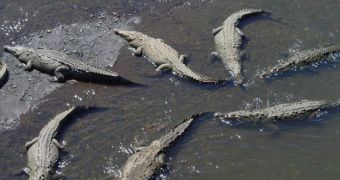One of the things that are very true about crocodiles – but which seem counterintuitive at first glance – is the fact that they are relatively poor swimmers, especially over large distances. Therefore, it has always been a mystery to biologists and other researchers how the animals manage to cross large swaths of water with apparent ease. In a new study, it was revealed that the crocodiles' secret is actually fairly simple. The reptiles like to surf atop ocean currents, which means that they actually place very little efforts into swimming per se. The finding was made by Australian researchers, PhysOrg reports.
The investigation was conducted entirely on salt-water crocodiles, by ecology scientists based at the University of Queensland (UQ). “Although it spends most of its life in salt-water, it cannot be considered a marine reptile in the same class as a turtle, as it relies upon the terrestrial environment for food and water. Many anecdotal accounts exist of large crocodiles being sighted far out to sea, but this is the first study to show – using underwater acoustic tags and satellite tracking – that estuarine crocodiles ride surface currents during long distance travel, which would enable them to travel between one oceanic island and another,” explains UQ School of Biological Sciences professor Dr Hamish Campbell, the leader of the team that conducted the work.
The UQ group worked in collaboration with colleagues from the Australia Zoo and the Queensland Parks and Wildlife Service, to determine that surfing was the method crocodiles used to populate a large number of islands in the South Pacific Ocean. “The data showed that crocodiles always began long-distance travel within an hour of the tide changing, allowing them to go with the flow, and that they halted their journeys by hauling out on to the river bank when the tide was against them,” Campbell adds. Details of the research were recently published in the latest issue of the British Ecological Society's respected scientific Journal of Animal Ecology.
“The estuarine crocodile exists as island populations throughout the Indian and Pacific ocean, and because only a single species of salt-water living crocodile exists across this vast area, regular mixing between the island populations probably occurs. It is unlikely that crocodiles swim across vast tracts of ocean, but they can survive for long periods in salt-water without the need for eating or drinking. By only traveling when surface currents were favorable, individuals would be able to move long distance by sea,” the expert adds. The new study was conducted on a number of 27 adult crocodiles, all of them from the Kennedy River, in North Queensland. The animals were tagged with sonar transmitters, and underwater listening stations then picked up their patterns of movement for an entire year.

 14 DAY TRIAL //
14 DAY TRIAL //